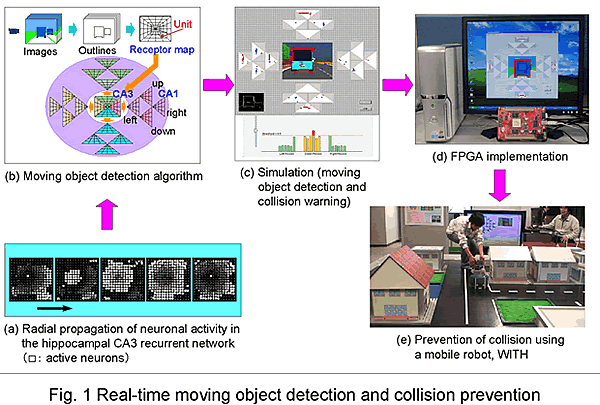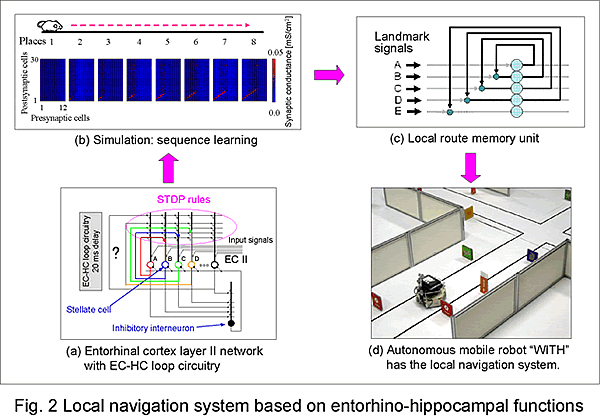 |
 |
 |
[ Temporal information processing devices and systems ] |
 |
 |
Sub-project leader : Hayashi |
|
 |
|
 |
 |
Sequence-data processing algorithms based on hippocampal functions and their hardware implementation
| (1) |
Outline of the sub-project
Functional abilities of the hippocampus are space recognition and sequence learning. The purposes of this project are to develop (1) real-time moving object detection and (2) local navigation systems based on hippocampal functions.
 |
Real-time moving object detection system
When signals are fed to several sites in the network, a spatio-temporal pattern containing propagation of neuronal activity is created depending on the sequence of the signals (Fig. 1a) [1-3]. This spatio-temporal pattern may be used to detect and learn a sequence of signals [4, 5]. If these signals are image frames, it is possible to detect objects moving in those frames. In this research project, as shown in Fig. 1b, an algorithm to detect moving objects, which simultaneously detects location, direction, and velocity of the objects, was developed in Hayashi Lab covering the field of brain-modeling [6-8]. Then, using output patterns of the moving object detection system, a fuzzy inference system for collision warning based on human intelligence was developed in Hayashi Lab in collaboration with Miki Lab covering the field of soft-computing (Fig. 1c) [11]. One of the features of the algorithm is parallel processing, so that it is suitable for real-time processing using integrated circuits. So, a digital LSI architecture for the moving object detection algorithm was developed in Morie Lab covering the field of LSI systems in collaboration with Hayashi Lab, and it was implemented on an FPGA (Fig. 1d) [9-11]. A mobile robot, WITH, equipped with the moving object detection and collision warning systems operated properly and prevented collisions, such as head-on collision, offset collision, and so on (Fig. 1e) [11]. The present system operating in real-time would be effective in preventing collision between cars.
|
 |
 |
| Page top ↑ |
 |
Local navigation system
Entorhino-hippocampal loop connections are selectively augmented by sensory signals conveying spatial information (Fig. 2a). As a result, entorhinal place cells are connected successively by loop connections, and a sequence of places is stored in the entorhinal cortex (Fig. 2b) [12-15]. A local navigation system based on the structure of the loop circuitry and the biological mechanism of sequence learning was developed in Miki Lab covering the field of soft-computing in collaboration with Hayashi Lab covering the field of brain-modeling [16]. This system extracts landmarks from camera images and stores them as route information. Then, the system autonomously executes navigation based on the local route information. Route information stored in the local route memory unit (Fig. 2c), which is the center of the system, is compared with a sequence of landmarks currently detected. If there is a small change in the sequence, the local route memory unit adapts itself to the change. It was verified that the local navigation system worked well using a mobile robot, WITH (Fig. 2d). The present local navigation system would enable robots to learn and store routes autonomously in uncharted space and move autonomously according to the learned routes.
|
 |
 |
| Page top ↑ |
|
 |
| (2) |
Members of the sub-project
| Sub-project leader |
 |
Hatsuo Hayashi (brain-modeling) |
: |
Development of algorithms of moving object detection and local navigation based on hippocampal functions of space recognition and sequence learning. |
| Members |
 |
Takashi Morie (LSI systems) |
: |
Hardware implementation of the moving object detection algorithm, system design, and equipment of a mobile robot with the implemented hardware. |
 |
Tsutomu Miki (soft-computing) |
: |
Development of a collision warning algorithm using fuzzy inference techniques, development of local navigation algorithm based on hippocampal functions, system design, and loading a mobile robot with the algorithms. |
 |
Kazuki Nakada (LSI systems) |
: |
Hardware implementation of the moving object detection algorithm, system design, and equipment of a mobile robot with the implemented hardware. |
|
 |
| (3) |
Figures
See attached sheets (photographs).
|
 |
|
 |
| References |
| [1] |
M. Yoshida, H. Hayashi, Regulation of spontaneous rhythmic activity and organization of pacemakers as memory traces by spike-timing-dependent synaptic plasticity in a hippocampal model, Physical Review E, Vol. 69, 011910: pp. 1-15, 2004.
|
| [2] |
H. Hayashi, M. Yoshida, A memory model based on dynamical behavior of the hippocampus, Proceedings of International Conference on Knowledge-Based Intelligent Information and Engineering Systems, Part 1, pp. 967-973, 2004.
|
| [3] |
H. Hayashi, M. Yoshida, A memory model of the hippocampus for the foundation of brain-inspired information technology, International Congress Series, Vol. 1269, pp. 109-112, 2004.
|
| [4] |
M. Yoshida, H. Hayashi, Organization of cell assemblies that code temporal sequences in a hippocampal CA3-CA1 model, Proceedings of the International Joint Conference on Neural Networks, pp.495-500, 2004.
|
| [5] |
M. Yoshida, H. Hayashi, Emergence of sequence sensitivity in a hippocampal CA3-CA1 model, Neural Networks, Vol. 20, No. 6, pp. 653-667, 2007.
|
| [6] |
H. Liang, T. Morie, H. Nakayama, K. Nakada, and H. Hayashi, A digital LSI architecture for moving detection based on sequence coding in a model of hippocampus, Proceedings of the Forum on Information Technology, pp.59-61, 2006 (in Japanese).
|
| [7] |
H. Hayashi, K. Nakada, T. Morie, A Moving object detection algorithm inspired by the sequence detection in the hippocampus and its digital LSI implementation, International Congress Series Vol. 1301, pp. 35-38, 2007.
|
| [8] |
H. Hayashi, PTC application for a patent, 2006.
|
| [9] |
H. Liang, H. Nakayama, K. Nakada, T. Morie, H. Hayashi, Digital VLSI implementation of a moving object detection algorithm based on neural propagation in the hippocampus, Proceedings of the International Symposium on Intelligent Signal Processing and Communication Systems, pp. 614-617, 2006.
|
| [10] |
H. Liang, T. Morie, H. Nakayama, K. Nakada, H. Hayashi, An FPGA-based real-time moving-object detection system based on neuronal propagation in the hippocampus, Proceedings of the International Workshop on Nonlinear Circuits and Signal Processing, pp.509-512, 2007.
|
| [11] |
H. Liang, T. Morie, Y. Suzuki, K. Nakada, T. Miki, H. Hayashi, An FPGA-based collision warning system using hybrid approach, Proceedings of the International Conference on Hybrid Intelligent Systems, pp.30-35, 2007.
|
| [12] |
J. Igarashi, M. Yoshida, K. Tateno, H. Hayashi, Synchronized subthreshold oscillations and phase coding in a network model of the entorhinal cortex, Proceedings of the International Joint Conference on Neural Networks, pp.3119-3124, 2004.
|
| [13] |
J. Igarashi, H. Hayashi, K. Tateno, Theta phase coding in entorhinal-hippocampal loop circuits organized by afferent signals, Proceedings of the International Symposium on Nonlinear Theory and its Applications, pp.595-598, 2006.
|
| [14] |
J. Igarashi, K. Tateno, H. Hayashi, Phase coding by organization of entorhinal cortex-hippocampus loop circuits, International Congress Series, Vol. 1291, pp. 117-120, 2006.
|
| [15] |
J. Igarashi, H. Hayashi, K. Tateno, Theta phase coding in a network model of the entorhinal cortex layer II with entorhinal-hippocampal loop connections, Cognitive Neurodynamics, Vol. 1, Issue 2, pp. 169-184, 2007.
|
| [16] |
T. Miki, H. Hayashi, Y. Goto, T. Inoue, M. Watanabe, Practical Local Navigation System Based on Entorhino-hippocampal Functions, Proceedings of Joint 4th International Conference on Soft Computing and Intelligent Systems and 9th International Symposium on advanced Intelligent Systems, pp.1783-1787, 2008.
|
|
|
|